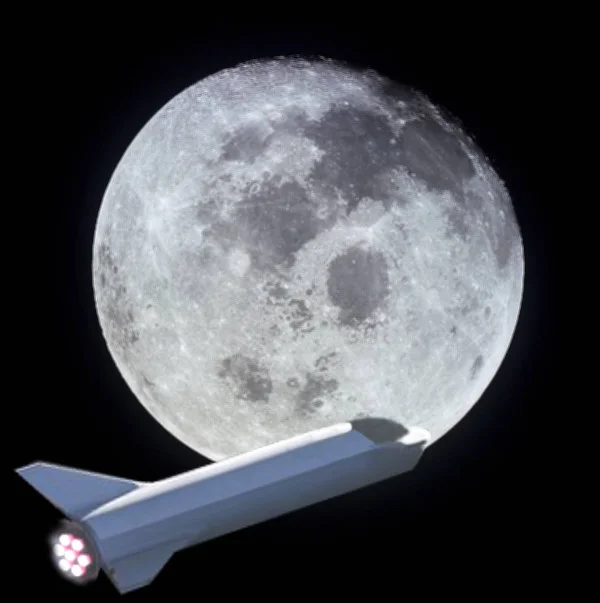HITCH A RIDE TO THE MOON?
/You’ve just opened an invitation: it says you’ve got an exclusive seat reserved on a spacecraft that will soar to the Moon and back. But you have to give an answer in five minutes. GO!
Would you do it?
I’m not talking science fiction this time. Elon Musk’s SpaceX rocket-building company intends to send their Big Falcon Rocket (say it with a slight slur and yes, the name’s an intentional joke, but it’s also real) out around the Moon carrying nine passengers as early as 2023. The passengers will be Japanese e-commerce billionaire Yusaku Maezawa and perhaps eight artists of various disciplines. Maezawa has booked the flight at a price tag rumoured to cover most of the project’s five-billion-dollar cost, but he hasn’t said who he has in mind to invite along. Maybe just artists. But maybe not. What if he changes his mind? What if he decides to hold a lottery?
One time, many years ago, in my radio career, I was doing the commentary at an air show. A parachutist approached and asked if anyone wanted to join him on a tandem jump—right then. If I’d said yes, I’d have been in the air ten minutes later ready to fall out of a plane and plummet toward the Earth, trusting my life to a stranger and a big sheet of fabric. I wanted to go—I’d always said I’d like to try sky-diving. But I didn’t. For one thing, the air show commentary was my responsibility and finding someone to fill in on such short notice wouldn’t be easy, or considerate to the organizers. For another, my young son was with me, and would be watching if I went splat. So I passed.
I have to admit that if I had the same offer today, I’d probably just plain chicken out, no excuse required.
But would I like to ride a rocket and pay a close-up visit to the Moon? I’m a science fiction writer—of course I would!
In theory.
The reality is that travel by rocket is still really risky. Rockets do still explode on the pad or during launch, sometimes destroying satellites and probes worth many millions of dollars (SpaceX itself has seen a half-dozen of its rockets explode, though a number were while attempting to land on their tails—a technique that has more recently become consistently successful). Lives aren’t usually lost because human flights are a very small percentage of rocket launches, but it has happened and could happen again. You could beat the odds to get a seat on the flight, only to beat the odds in a much more unfortunate way. And the launch is not the only dangerous part by any means. Maezawa and his companions will be flung out on a round trip of nearly 800,000 kilometres—four days on their own, far beyond any hope of help should they get into trouble. The FBR is big, designed to eventually ferry up to one hundred commercial passengers at a time, but on this first jaunt the surplus space will be used to carry extra fuel and food supplies in case something goes wrong.
What could go wrong? Anything. Everything. Failures that would be meaningless on Earth might be critical in the freezing vacuum of space hundreds of thousands of kilometres from home.
Hang on…is science fiction writer Scott Overton hinting that he might turn down a chance to travel to the Moon?
I don’t think I’m a coward. I’ve happily flown in all kinds of different aircraft of various sizes and vintages, and would once have ridden shotgun with Canada’s Snowbirds aerobatic team if the weather had cooperated. At some point, commercial flights to the Moon will have a track record of safety, and there will be an established infrastructure for rescue missions. That sounds worth waiting for, doesn’t it? The Maezawa junket won’t land either—it won’t even go into Moon orbit, but just swing around once and head back to Earth. If I ever go that far, I’ll darn well want to land and walk around! Otherwise, although I’m sure the view will be mind-boggling, there just might be an element like when I visited the Grand Canyon and didn’t go down into it. After taking in the “breathtaking vistas” I realized that it looked just like all of the pictures I’d seen of it. It was too big. Untouchable. So the experience was ultimately lacking.
But isn’t there something irresistible about being among the first private citizens to go to the Moon? Well, we all remember Neil Armstrong, Buzz Aldrin, and maybe Michael Collins (who stayed in the Apollo 11 command module and didn’t land), but 21 other men went to the Moon. How many of the others can you name? Maybe some of the artists who accompany Maezawa will be remembered if the art they produce is of lasting value, otherwise they’ll just be “also along for the ride”. And before you judge me too harshly, Maezawa has invited Elon Musk himself along, and Musk has indicated he might go. Only might. This from the guy whose company actually builds the rockets. In his words, “When you’re pushing the frontier, it’s not a sure thing.”
If all this sounds like sour grapes because I’m not likely to be aboard the FBR for its epic journey, I’m not saying I would turn down an invitation, just that it might not be the automatic Yes that my chosen vocation would seem to dictate. If I’m honest.
Still, Yusaku Maezawa, if you’re reading this…it never hurts to talk, right?





